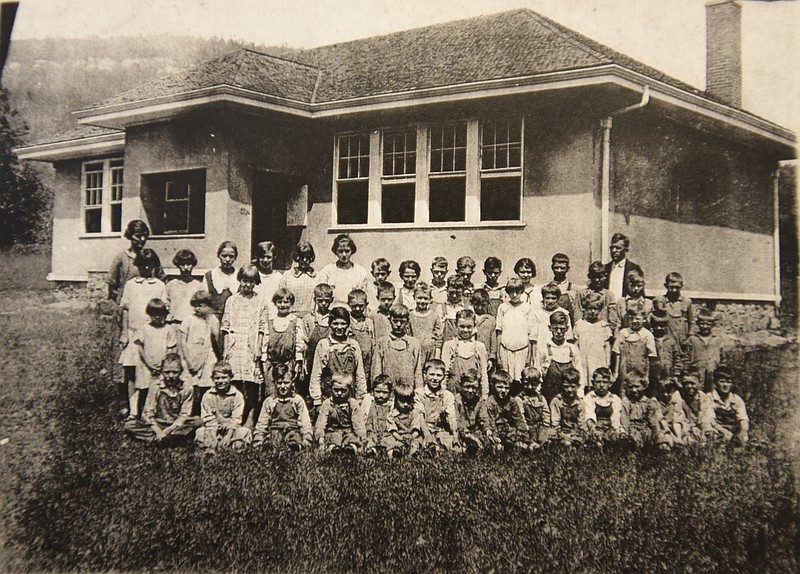George Selcer remembers listening to his daddy tell stories about his time at Falling Water Elementary nearly a century ago. The trees his dad, Wallace "Gumbo" Selcer, planted still stand strong outside the school.
Sitting in his recliner, George Selcer likes to reminisce about the Roy Rogers cowboy films he and his classmates watched at the school for just 10 cents, and what the outhouses behind the school were like when he attended in the 1940s.
Now he listens as his great-grandchildren tell stories about their third-grade class at Falling Water. They are the fifth generation of the Selcer line to attend the school nestled at the foot of Walden's Ridge.
But the family's tradition is ending. The 104-year-old school of fewer than 200 students is scheduled to close for good this summer, as the Hamilton County Department of Education is moving toward what it says is a more cost-effective "mega-school" model.
For George Selcer and his family, the closing of the elementary school is the end of a legacy, the prize of the rural Falling Water community.
"The church is right down there, and the school is right over there, and that's what makes Falling Water," Selcer said. "It's all I've ever known."
That multiple generations attended the community school is one of the reasons it remains a pillar in the community and has earned such success, said Lee Ann Burk, principal at Falling Water Elementary.
Despite Falling Water Elementary being a Title I school, meaning a large share of poor children attend, the school was named one of just 285 Blue Ribbon Schools by the U.S. Department of Education last year. The school earned the prestigious award for its success closing achievement gaps between students.
Last year, 56 percent of its students were considered economically disadvantaged, yet Falling Water tested above the state and Hamilton County's standardized test average in every subject.
Walking down the creaky, wood-floored hallway, Burk said she knows the building doesn't have the newest technology or fancy facilities, but what makes Falling Water successful is the relationships that exist within the schoolhouse.
"School is not about the equipment in the building. You can have all the equipment in the world and not make progress," Burk said. "But if you have the relationships and know where kids are and where they need to be, you can make progress."
Burk said the small staff - just two teachers to each grade - has allowed her to be innovative. She can personally make sure every student meets target benchmarks, and call parents if they weren't. Next year, Burk is moving to a school about four times the size of Falling Water - Snow Hill Elementary - and said she will miss not knowing the names of each student as she does now.
Parents and teachers say they are afraid students' test scores will go down when they are sent to much larger schools, and several national research studies back up their concerns.
One study, conducted by the Rural School and Community Trust, a nonprofit educational research organization, found that smaller schools help students from less affluent communities narrow the academic achievement gap with wealthier peers.
Looking at performance at a range of schools in Georgia, Ohio, Montana and Texas, researchers found the correlation between poverty and low achievement is as much as 10 times stronger in larger schools than in smaller ones in all four states.
Falling Water is in Hamilton County school board member Rhonda Thurman's district. Thurman said she didn't want to see it close and is proud of its success. But she knows major improvements the building needs are too costly to be affordable.
Thurman said county leaders want to have "mega-schools" that reduce operational costs, and they are no longer willing to pay for building or repairing small community schools like Falling Water Elementary.
The new Ganns Middle Valley Elementary, opening in August, will hold about 1,000 students, and it's expected that some from Falling Water will attend. The remainder of Falling Water's students are expected to be split between the new Hixson Elementary and Soddy Elementary once the school board votes on the zoning changes.
Karen Johnson said it's a shame that kids who have been in classes together for so many years will be split up. Johnson, her daughter and now her grandchildren all went to school in the same first-grade classroom. She said it will be a shock for a lot of kids to move to such big schools.
And teachers say they're nervous, too.
Gina Phillips attended Falling Water as a child and has taught there for 27 years. She plans to transfer to Ganns Middle Valley next school year, and anticipates a big transition.
"It breaks my heart to leave, because I grew up here," she said.
The thing she'll miss the most about teaching at Falling Water is it's one of the few schools where teachers still have the opportunity to split subjects with another teacher, allowing her to specialize in math and science.
"When I'm teaching all the subjects next year, I will become more of a generalist," Phillips said. "I don't think that's as good for me or the kids."
Ben Cunningham and Jase Moses are finishing fifth grade at Falling Water and said they are proud to be in the school's last class.
The boys are excited for middle school but say they are going to miss their memories of Falling Water, especially on the playground and in the cafeteria.
Pointing to a stain on the wall, Ben proudly said that was his fault, saying his yogurt exploded one day during lunch years ago.
"It was really, really funny," he said. "I'll never forget it."
Jase said he is going to miss the pictures painted on the school's walls and knowing all his teachers.
Both boys giggled and said they rarely misbehaved at school because all the teachers knew them and their parents.
On Saturday, the boys and many of their classmates gathered with about 500 community members for a celebration.
Pictures from nearly each decade of the school's existence hung on the wall. Kids laughed at the hairstyles from the 1980s, while parents pointed to their class pictures. Neighbors - many wearing black shirts bearing the school's name - reminisced and shared hugs.
In the cafeteria, students sang to a packed crowd, with Hamilton County Mayor Jim Coppinger, Thurman and several county commissioners sitting in the front row taking pictures.
As the school year comes to a close, so does Peggy Shelton's teaching career. She plans to retire after 31 years at Falling Water.
Shelton said this was her first and only teaching job, and she can't imagine teaching anywhere else.
"Once you find the right school, you never want to leave," Shelton said. "I guess I'm just going down with the ship."
Contact staff writer Kendi Anderson at kendi.anderson@timesfreepress.com or 423-757-6592. Follow on twitter @kendi_and.

